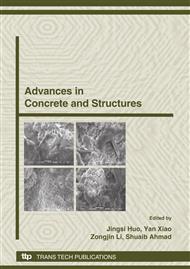p.275
p.281
p.287
p.295
p.301
p.311
p.321
p.329
p.335
Modeling Cyclic Behavior of Reinforcing Steel: Relevance in Seismic Response Analysis of Reinforced Concrete Structures
Abstract:
In nonlinear dynamic analyses of RC structures based on fiber-based discretization of member cross-sections, the constitutive model used to represent the cyclic behavior of reinforcing steel typically plays a significant role in controlling the structural response especially for nonductile systems. The accuracy of a fiber-section model is almost entirely dependent on the ability of both the concrete and reinforcing steel constitutive material models to represent the overall inelastic behavior of the member. This paper describes observations related to the fundamental properties of reinforcing steel such as buckling, hardening, diminishing yield plateau and growth of curvature, Bauschinger effect, and low-cycle fatigue and strength degradation that are relevant to the overall task of developing an accurate material model for use in seismic response analysis of reinforced concrete structures.
Info:
Periodical:
Pages:
301-309
Citation:
Online since:
October 2008
Authors:
Price:
Сopyright:
© 2009 Trans Tech Publications Ltd. All Rights Reserved
Share:
Citation:


